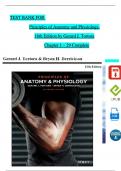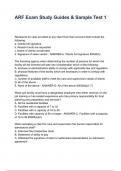TEST BANK FOR
Principles of Anatomy and Physiology,
16th Edition by Gerard J. Tortora
Chapter 1 – 29 Complete
,
,Chapter 01 An Introduction to the Human Body
Question type: Multiple Choice :
1) Which describes the study of the functions of body structures?
a) Anatomy
b) Physiology
c) Endocrinology
d) Histology
e) Immunology
ANSWER: b
Difficulty: Easy
Bloomcode: Knowledge
Learning Objective 1: LO 1.1 Define anatomy and physiology, and name several branches of
these sciences.
Section Reference 1: Sec 1.1 Anatomy and Physiology Defined
Question type: Multiple Choice
2) A group of cells that work together to perform a particular function is a(n)
a) tissue.
b) organ.
c) molecules.
d) compounds.
e) organism.
ANSWER: a
Difficulty: Easy
Bloomcode: Knowledge
Learning Objective 1: LO1.2 Identify the locations and functions of each of the organ systems
and major organs of the human body.
Section Reference 1: Sec 1.2 Levels of Structural Organization and Body Systems.
,Question type: Multiple Selection
3) What process occurs when amino acids build new proteins? Select all that apply.
a) Metabolism
b) Anabolism
c) Catabolism
d) Responsiveness
e) Differentiation
Answer 1: a
Answer 2: b
Difficulty: Medium
Bloomcode: Application
Learning Objective 1: LO1.3 Define the important life processes of the human body.
Section Reference 1: Sec 1.3 Characteristics of the Living Human Organism
Question type: Essay
4) How are reproduction, differentiation and growth related?
ANSWER:
Difficulty: Hard
Bloomcode: Synthesis
Learning Objective 1: LO1.3 Define the important life processes of the human body.
Section Reference 1: Sec 1.3 Characteristics of the Living Human Organism
Solution: Reproduction occurs through the fertilization of an ovum by a sperm cell to form a
zygote, followed by repeated cell divisions and the differentiation of these cells. Growth is an
increase in body size that results from an increase in the size of existing cells, an increase in the
number of cells, or both.
Question type: Multiple Choice
5) The two organ systems that predominantly regulate and maintain homeostasis are the
a) cardiovascular and integumentary systems.
b) nervous and endocrine systems.
c) cardiovascular and respiratory systems.
,d) respiratory and muscular systems.
e) urinary and integumentary systems.
ANSWER: b
Difficulty: Easy
Bloomcode: Comprehension
Learning Objective 1: LO1.4 Explain the importance of homeostasis and describe the
relationship of homeostatic imbalances to disorders.
Section Reference 1: Sec 1.4 Homeostasis
6) Which body fluid fills the narrow spaces between cells and tissues?
a) Lymph
b) Blood plasma
c) Interstitial fluid
d) Intracellular fluid
e) Vitreous body
ANSWER: c
Difficulty: Medium
loomcode: Application
Learning Objective 1: LO1.4 Explain the importance of homeostasis and describe the
relationship of homeostatic imbalances to disorders.
Section Reference 1: Sec 1.4 Homeostasis
Question type: Essay
7) Describe the differences between positive and negative feedback systems.
ANSWER:
Difficulty: Medium
Bloomcode: Analysis
Learning Objective 1: LO1.4 Explain the importance of homeostasis and describe the
relationship of homeostatic imbalances to disorders.
Section Reference 1: Sec 1.4 Homeostasis
Solution: A positive feedback system will strengthen or reinforce a change in one of the body's
controlled conditions while a negative feedback system will reverse a change in a controlled
condition.
,Question type: Multiple Choice
8) Hormonal or electrical signals are sent from the control center to the
a) receptors.
b) stimulus.
c) afferent pathway.
d) effectors.
e) efferent pathway.
ANSWER: d
Difficulty: Medium
Bloomcode: Application
Learning Objective 1: LO1.4 Explain the importance of homeostasis and describe the
relationship of homeostatic imbalances to disorders.
Section Reference 1: Sec 1.4 Homeostasis
Question type: Multiple Choice
9) A component that detects decreasing oxygen concentrations in blood would be the
a) receptor.
b) muscle.
c) response.
d) effector.
ANSWER: a
Difficulty: Medium
Bloomcode: Analysis
Learning Objective 1: LO1.4 Explain the importance of homeostasis and describe the
relationship of homeostatic imbalances to disorders.
Section Reference 1: Sec 1.4 Homeostasis
Question type: Multiple Choice
10) If blood concentrations of thyroid hormones increase above a certain level, Thyroid releasing
hormone (TRH) neurons in the hypothalamus are inhibited and stop secreting TRH. This is an
example of
,a) negative feedback.
b) positive feedback.
ANSWER: a
Difficulty: Hard
Bloomcode: Evaluation
Learning Objective 1: LO1.4 Explain the importance of homeostasis and describe the
relationship of homeostatic imbalances to disorders.
Section Reference 1: Sec 1.4 Homeostasis
Question type: Multiple-Selection
11) Cardiomyopathy worsens as the heart weakens. Swelling in the legs occurs and is classified
as a… (Select all that apply.)
a) Symptom.
b) Disorder.
c) Disturbance.
d) Disease.
e) Sign.
Answer 1: b
Answer 2: c
Answer 3: e
Difficulty: Medium
Bloomcode: Analysis
Learning Objective 1: LO1.4 Explain the importance of homeostasis and describe the
relationship of homeostatic imbalances to disorders.
Section Reference 1: Sec 1.4 Homeostasis
Question type: Essay
12) Describe the anatomical position.
ANSWER:
Difficulty: Easy
Bloomcode: Comprehension
Learning Objective 1: LO1.5 Describe the human body using the anatomical position and
specific anatomical terminology.
,Section Reference 1: Sec 1.5 Basic Anatomical Terminology
Solution: In the anatomical position, the subject stands erect facing the observer with the head
level and the eyes facing forward. The feet are flat on the floor and directed forward and the
arms are at the sides with the palms turned forward.
Question type: Multiple Choice
13) Put the cavities in order from broadest to most specific in which the lungs are located.
a) Thoracic, ventral, parietal pleura, visceral pleura
b) Ventral, visceral pleura, thoracic, parietal pleura
c) Ventral, thoracic, parietal pleura, visceral pleura
d) Thoracic, ventral, visceral pleura, parietal pleura
ANSWER: c
Difficulty: Medium
Bloomcode: Analysis
Learning Objective 1: LO1.5 Describe the human body using the anatomical position and
specific anatomical terminology.
Section Reference 1: Sec 1.5 Basic Anatomical Terminology
Question type: Multiple Choice
14) Put the cavities in order from broadest to most specific in which the urinary bladder is
located
a) ventral, abdominopelvic, pelvic, parietal peritoneal, visceral peritoneal.
b) abdominopelvic, ventral. pelvic, visceral peritoneal, parietal peritoneal.
c) ventral, abdominopelvic, visceral peritoneal, pelvic, parietal peritoneal.
d) abdominopelvic, pelvic, ventral, parietal peritoneal, visceral peritoneal.
ANSWER: a
Difficulty: Medium
Bloomcode: Application
Learning Objective 1: LO1.5 Describe the human body using the anatomical position and
specific anatomical terminology.
Section Reference 1: Sec 1.5 Basic Anatomical Terminology
Question type: Multiple Choice
,15) Which cavity contains the heart?
a) Cranial cavity
b) Vertebral cavity
c) Abdominal cavity
d) Pericardial cavity
e) Pleural cavity
ANSWER: d
Difficulty: Easy
Bloomcode: Knowledge
Learning Objective 1: LO1.5 Describe the human body using the anatomical position and
specific anatomical terminology.
Section Reference 1: Sec 1.5 Basic Anatomical Terminology
Question type: Multiple Choice
16) The function of the secretions of the pleura is to
a) separate the thoracic and abdominal cavities.
b) protect the central nervous system.
c) prevent infection.
d) reduce friction between neighboring organs.
e) carry nervous impulses.
ANSWER: d
Difficulty: Medium
Bloomcode: Application
Learning Objective 1: LO1.5 Describe the human body using the anatomical position and
specific anatomical terminology.
Section Reference 1: Sec 1.5 Basic Anatomical Terminology
Question type: Multiple Choice
17) Cutting open the chest at the sternal marking would represent a(n)
a) sagittal plane.
b) midsagittal plane.
, c) transverse plane.
d) oblique plane.
e) coronal plane.
ANSWER: b
Difficulty: Medium
Bloomcode: Analysis
Learning Objective 1: LO1.5 Describe the human body using the anatomical position and
specific anatomical terminology.
Section Reference 1: Sec 1.5 Basic Anatomical Terminology
Question type: Multiple Choice
18) Amputation of the arm at the shoulder would be a(n)
a) frontal plane.
b) parasagittal plane.
c) transverse plane.
d) oblique plane.
e) midsagittal plane.
ANSWER: b
Difficulty: Medium
Bloomcode: Analysis
Learning Objective 1: LO1.5 Describe the human body using the anatomical position and
specific anatomical terminology.
Section Reference 1: Sec 1.5 Basic Anatomical Terminology
Question type: Multiple Choice
19) Cutting the body in half at the diaphragm, would create the thoracic cavity and the
abdominopelvic cavity. What plane would create these halves?
a) Frontal
b) Sagittal
c) Transverse
d) Oblique
e) Midsagittal
ANSWER: c





